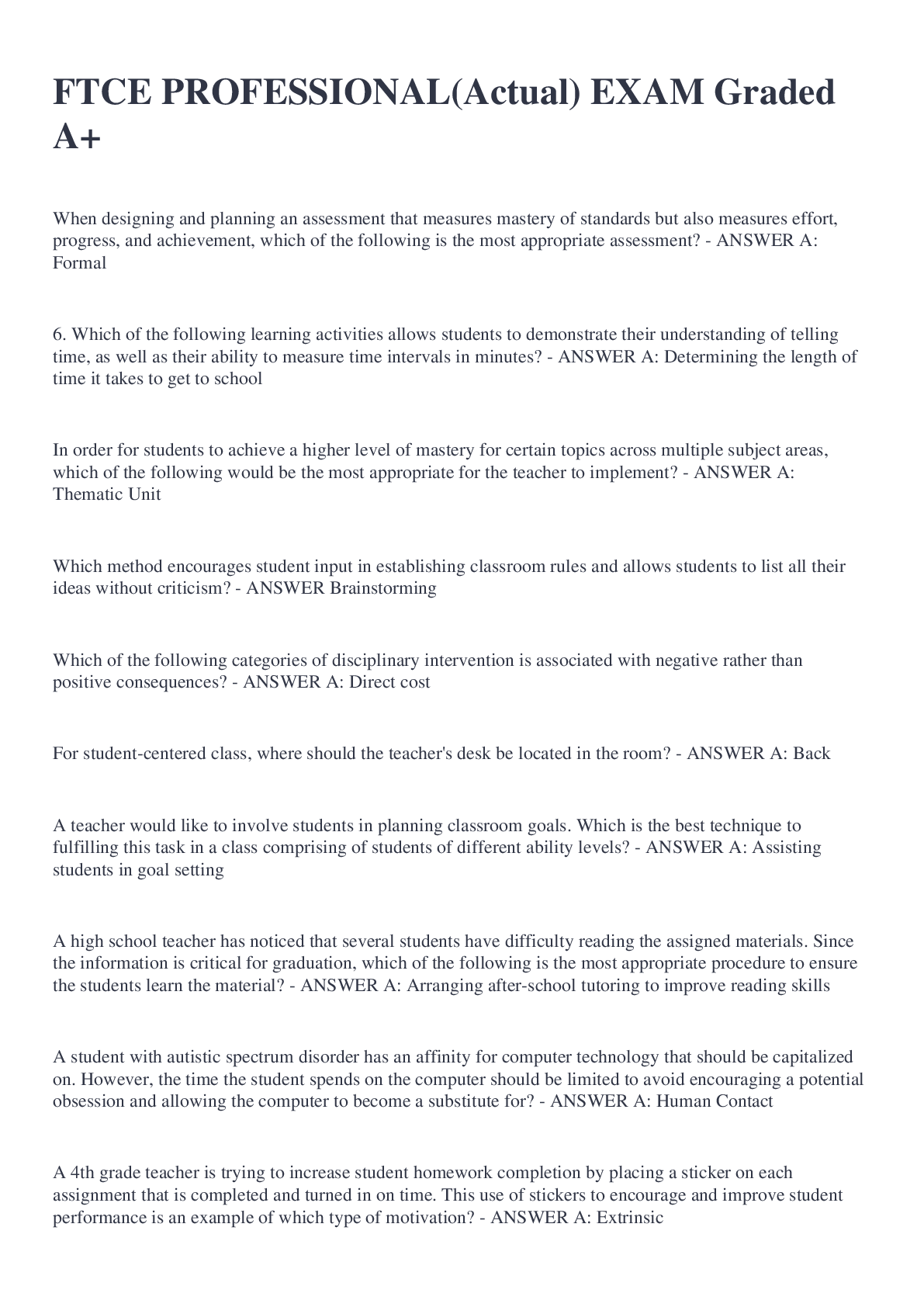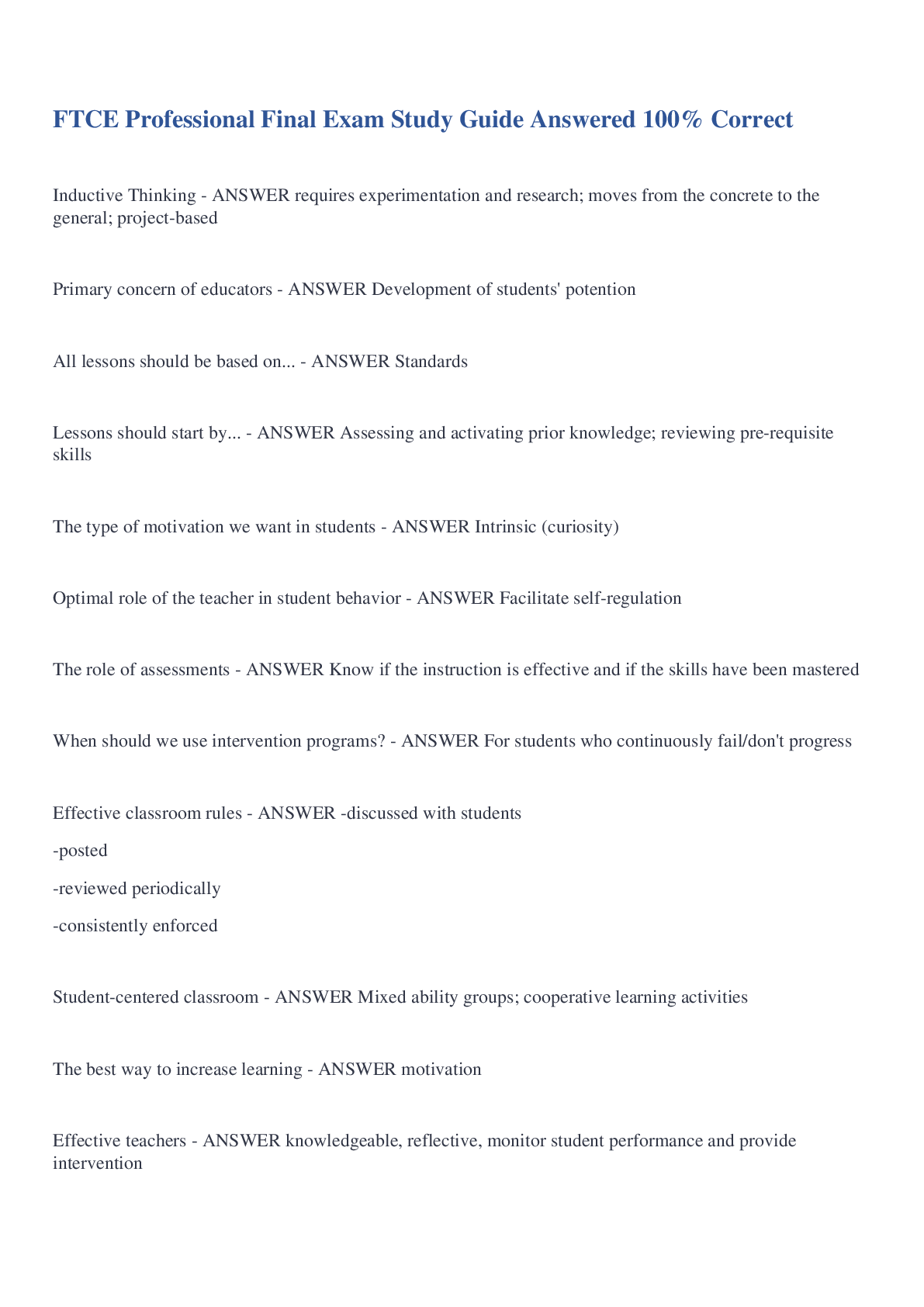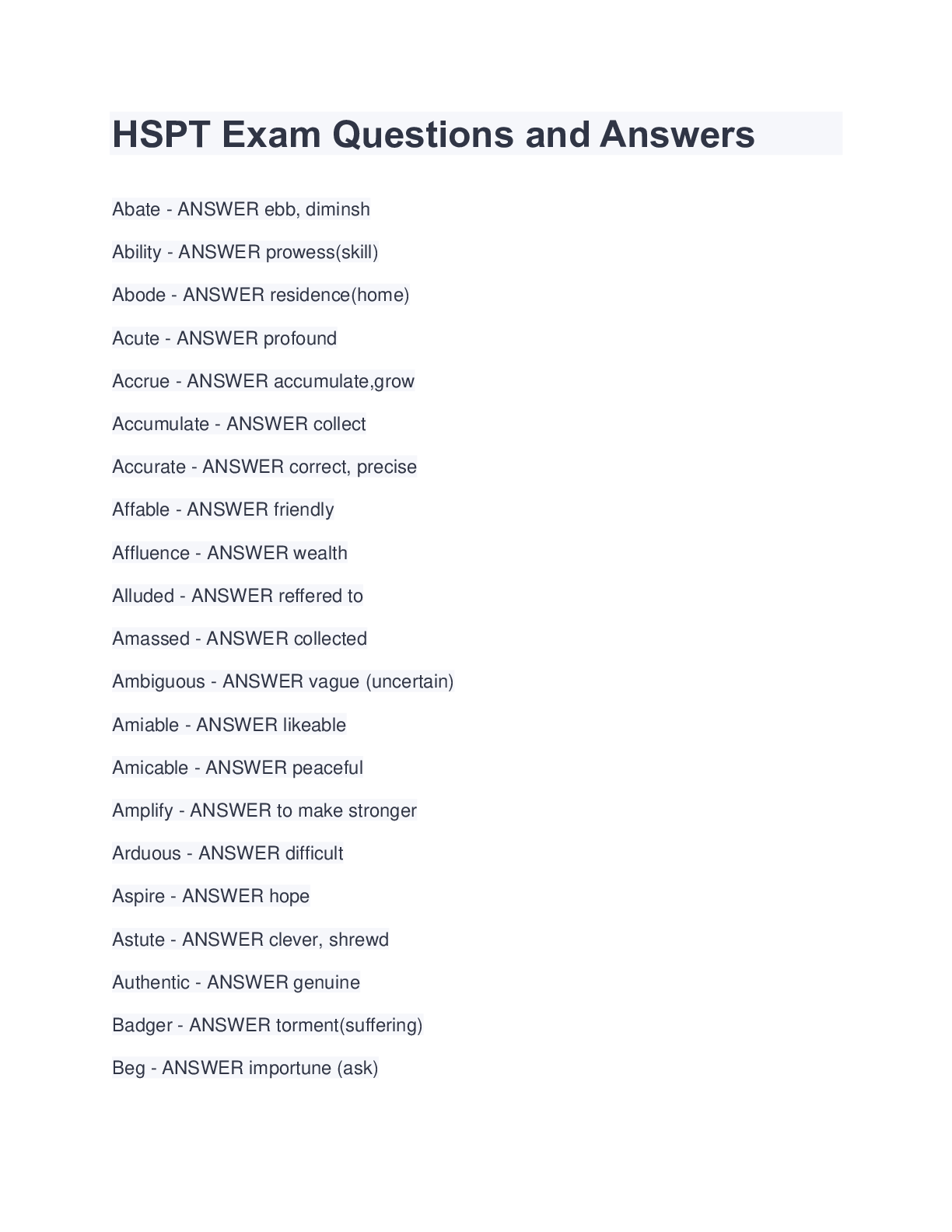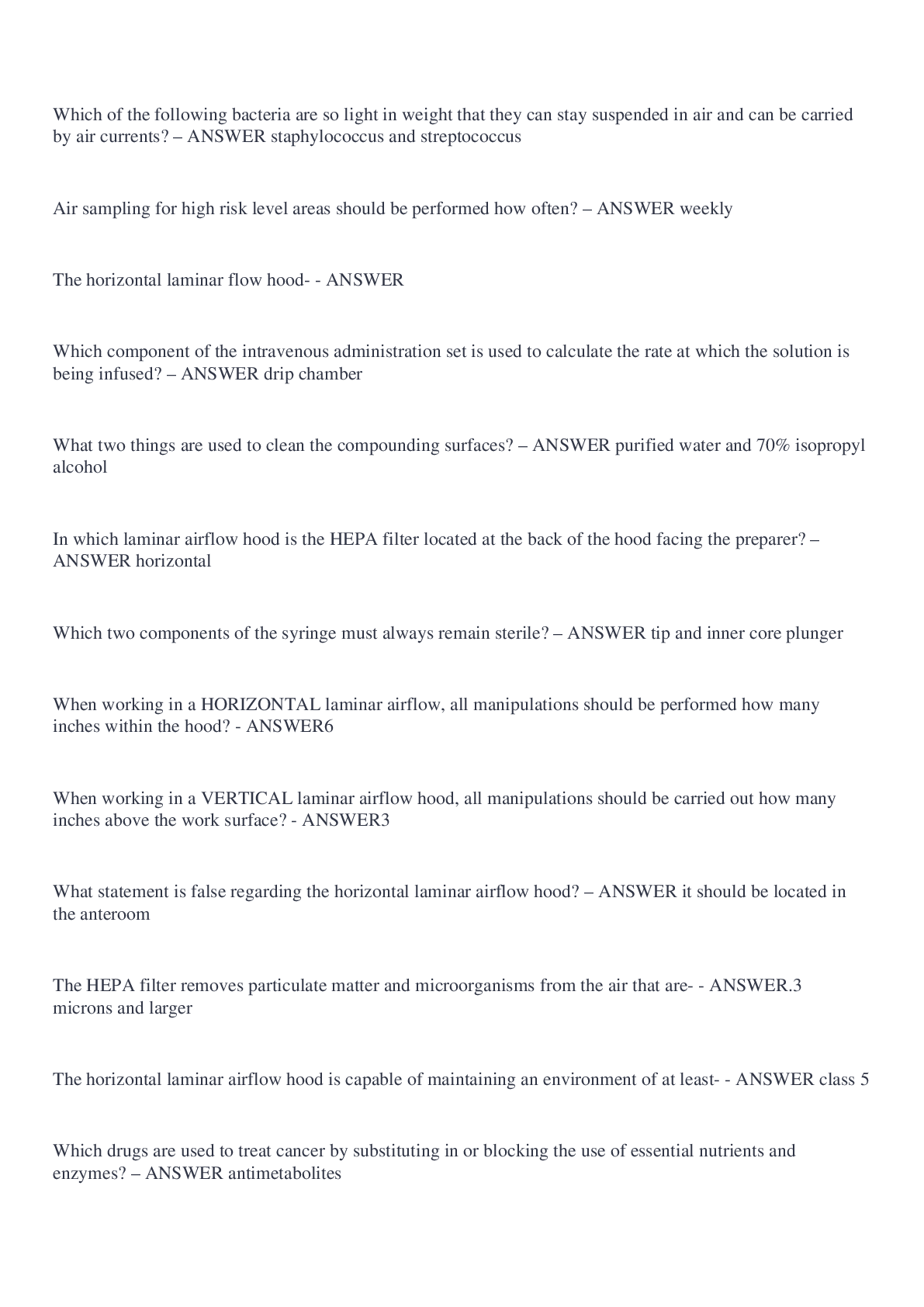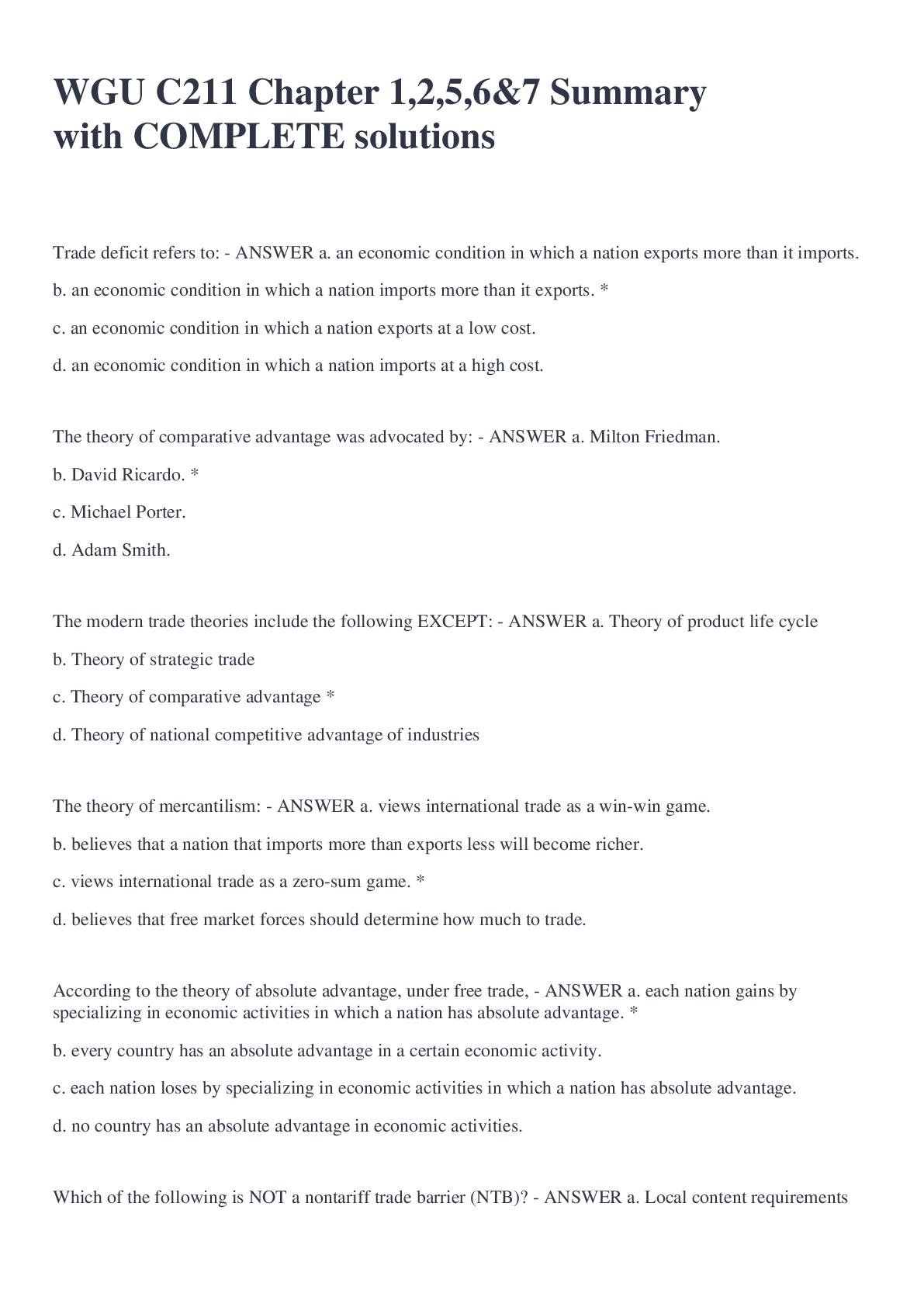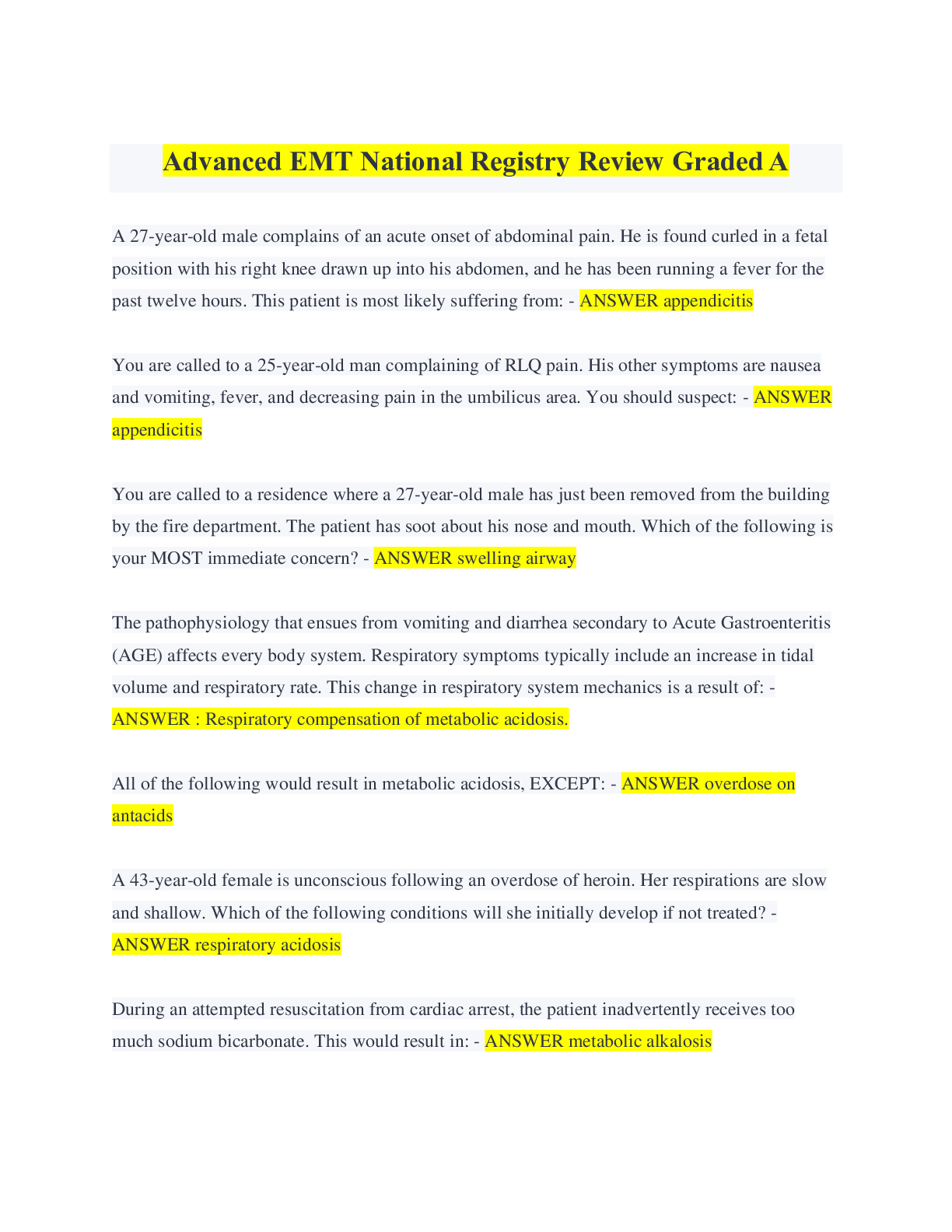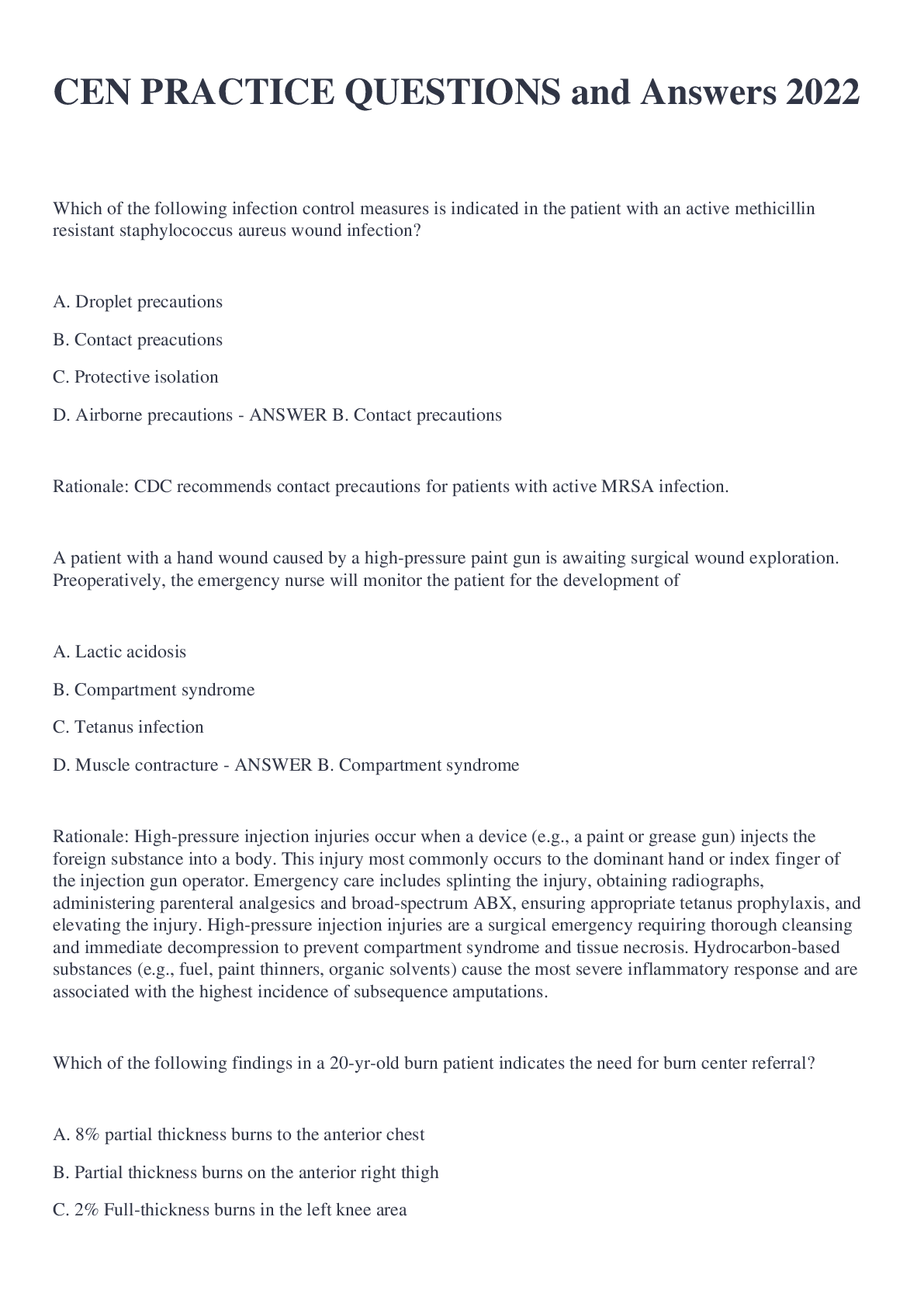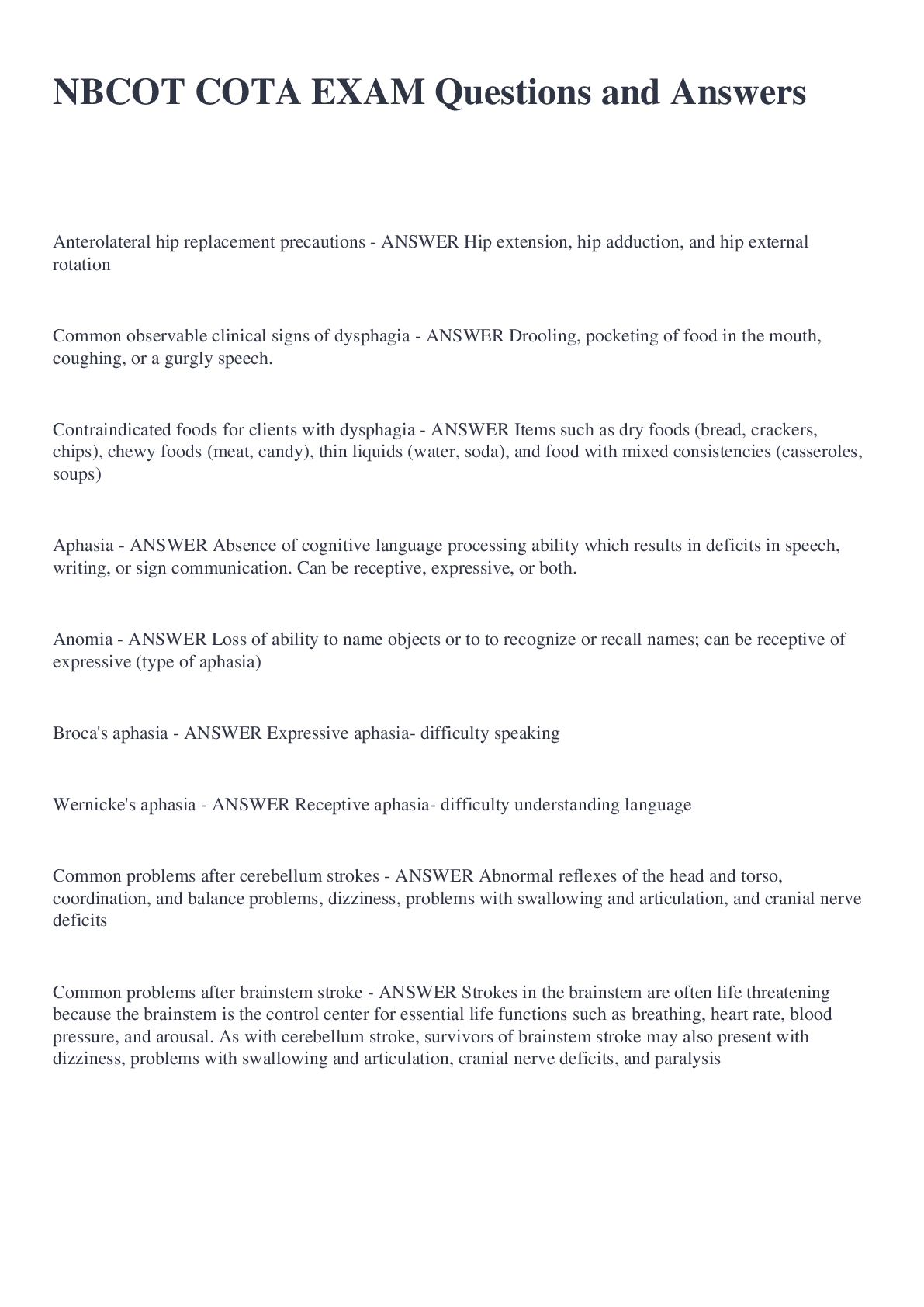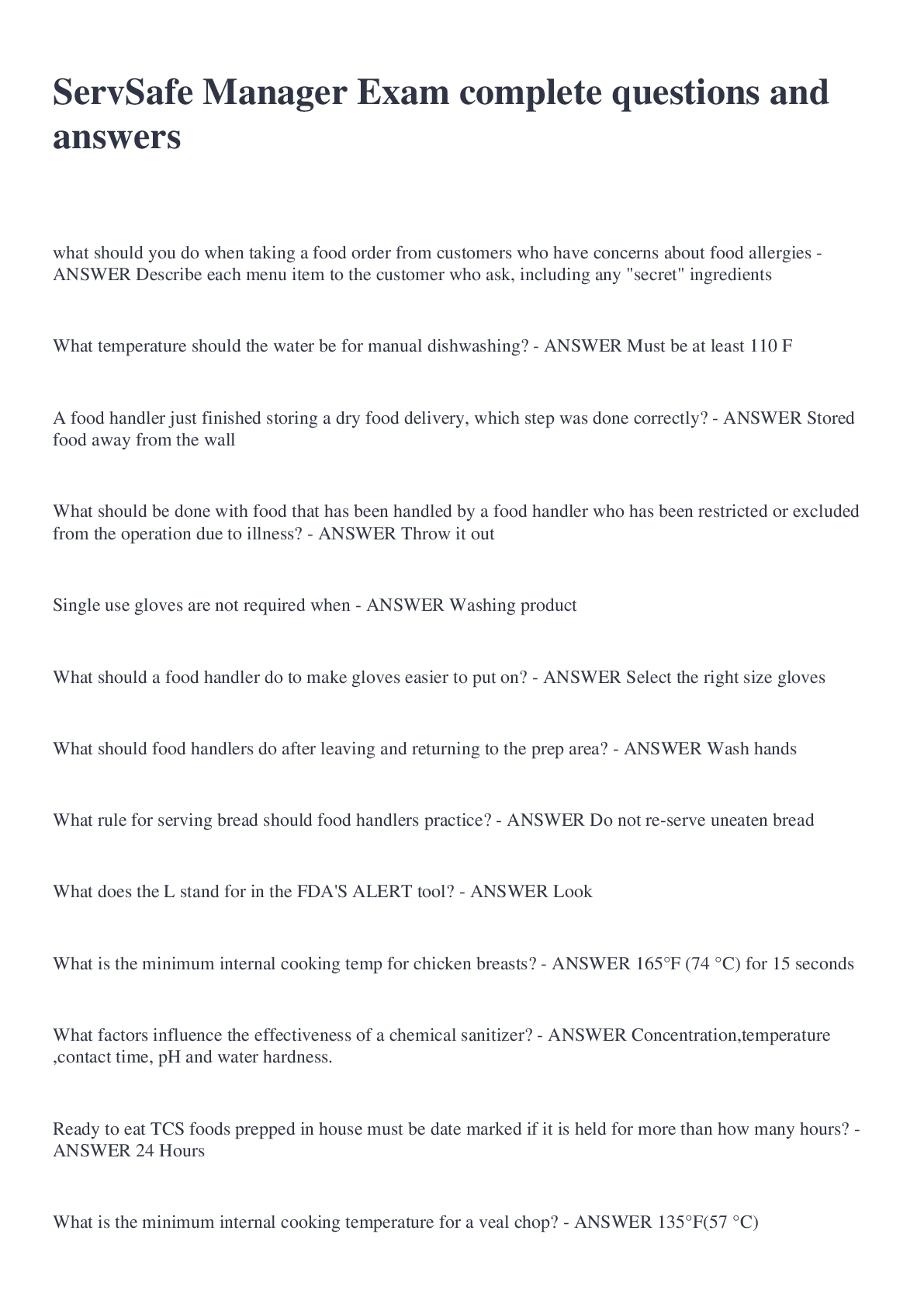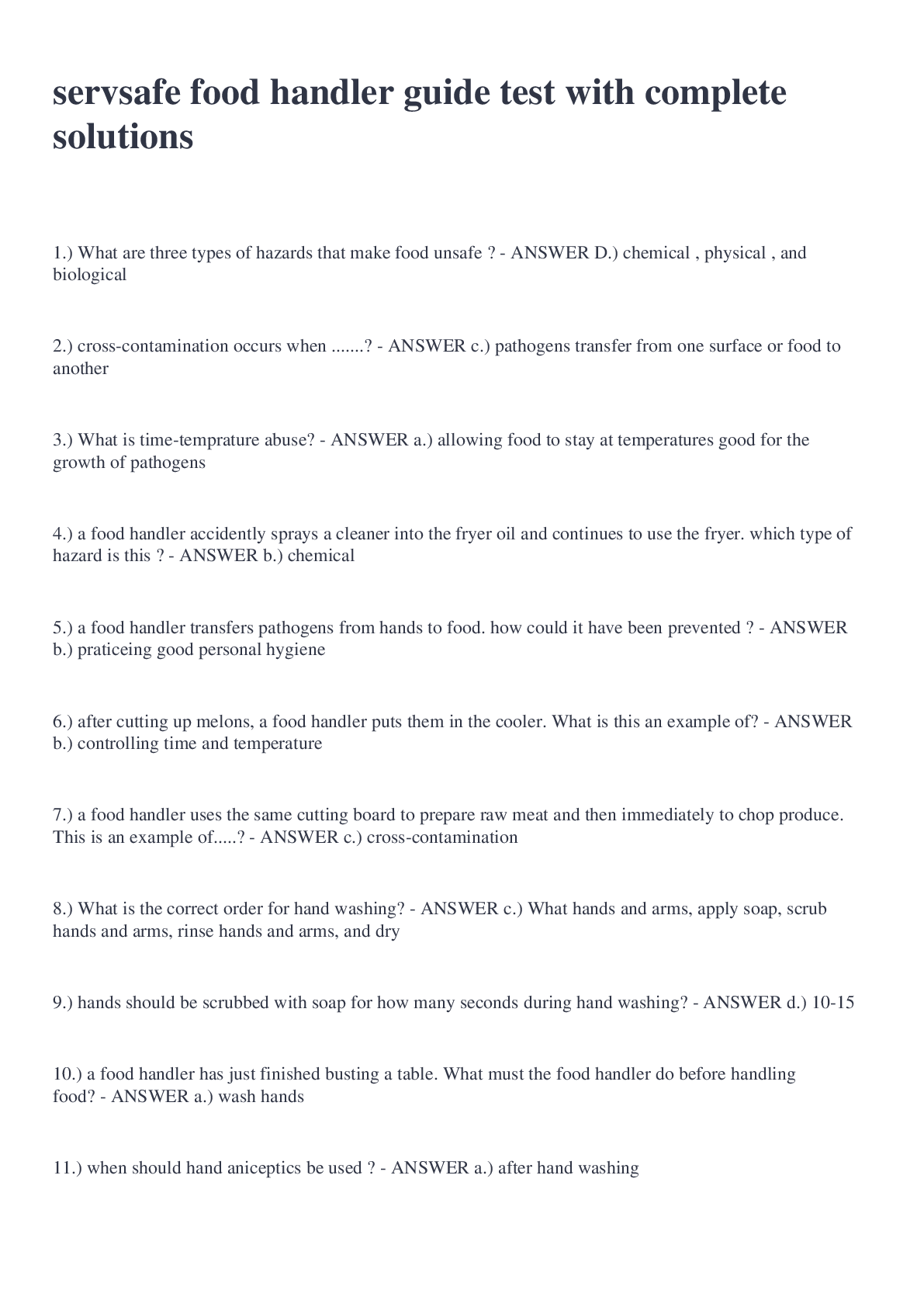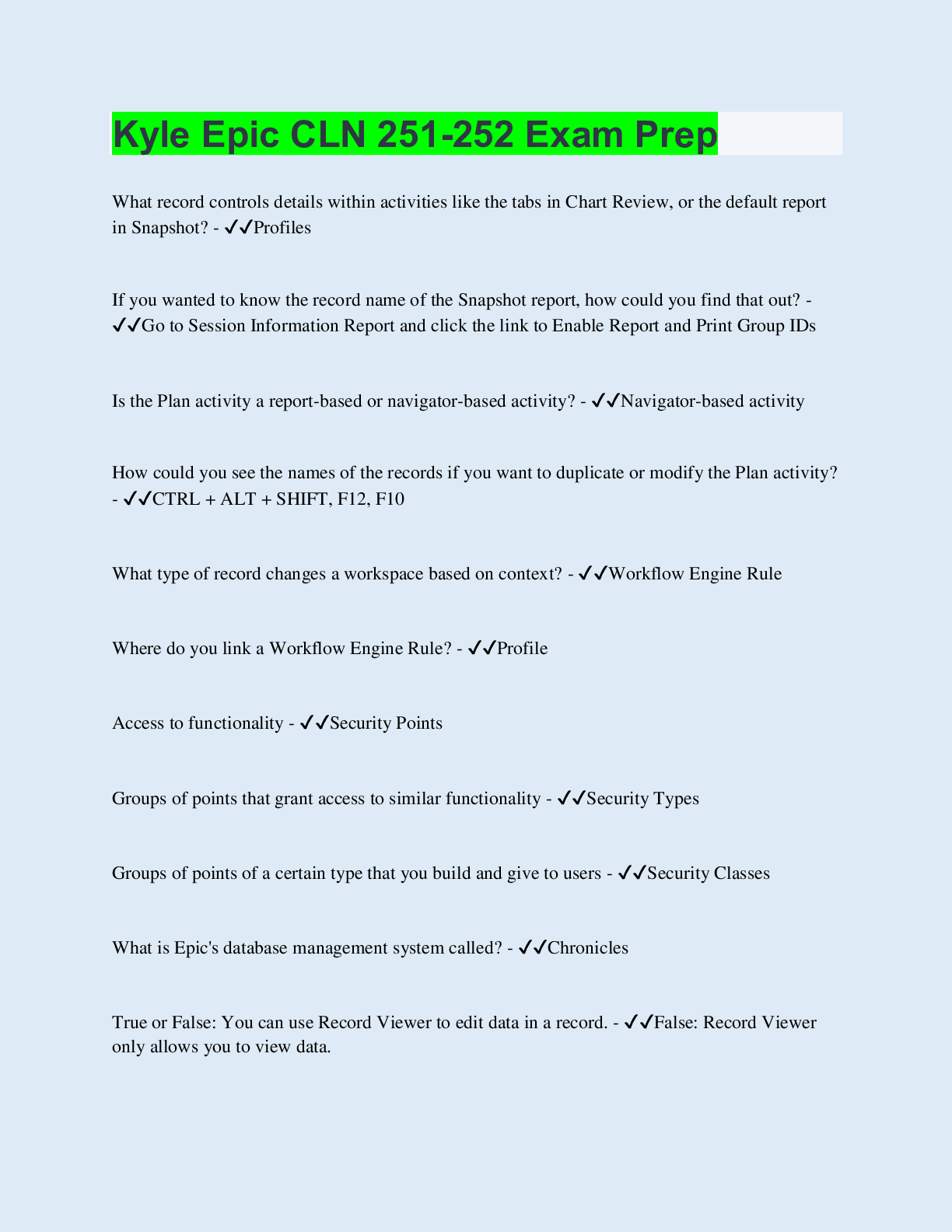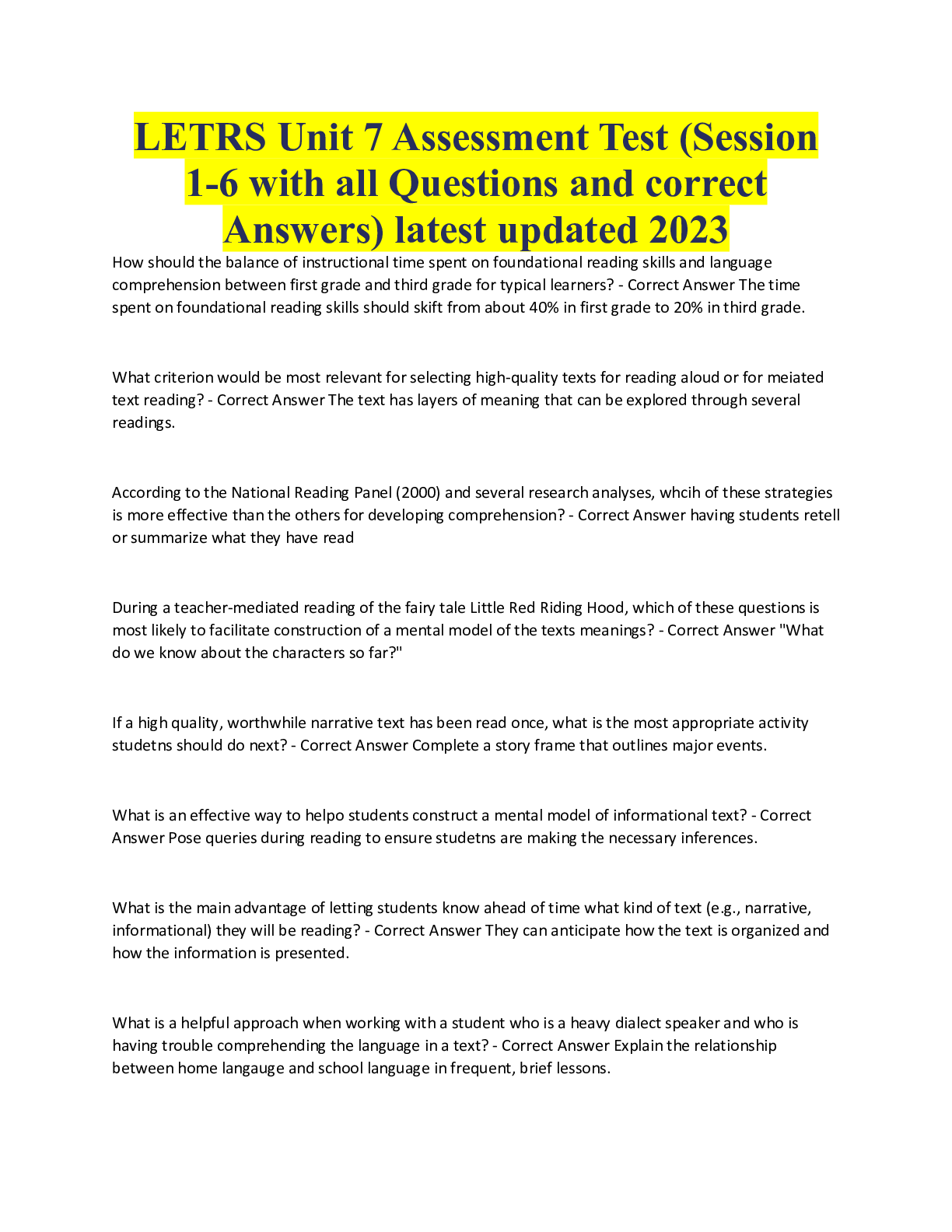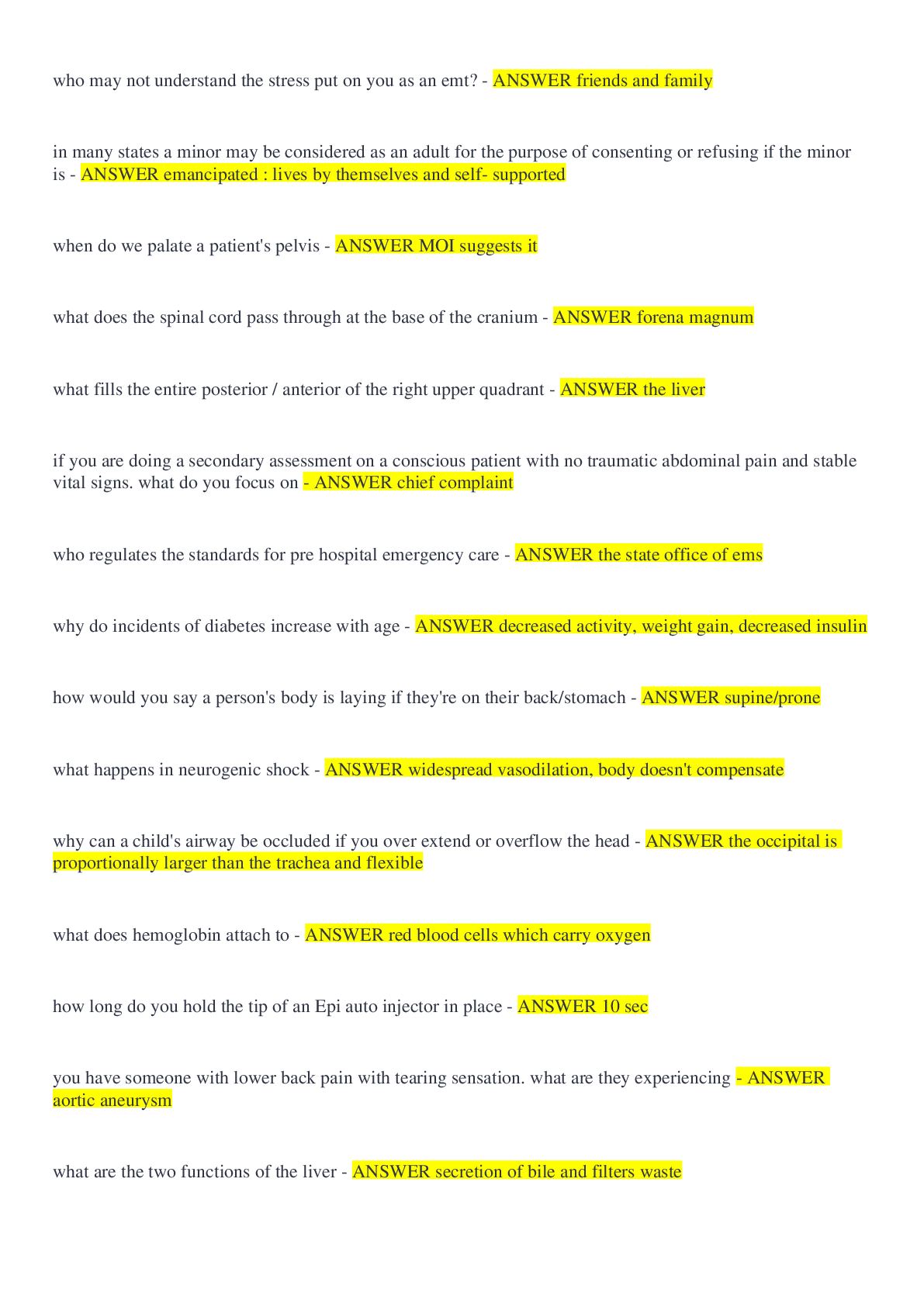Health Care > EXAM > EMT AAOS – ALL(Exam Questions and Answers) 2022/2023 (All)
EMT AAOS – ALL(Exam Questions and Answers) 2022/2023
Document Content and Description Below
advanced EMT (AEMT) - ANSWER An individual who has training in specific aspects of advanced life support, such as intravenous therapy, and the administration of certain emergency medications advanc... ed life support (ALS) - ANSWER Advanced lifesaving procedures, some of which are now being provided by the EMT Americans With Disabilities Act (ADA) - ANSWER Comprehensive legislation that is designed to protect individuals with disabilities against discrimination automated external defibrillator (AED) - ANSWER A device that detects treatable life-threatening cardiac arrhythmias (ventricular fibrillation and ventricular tachycardia) and delivers the appropriate electrical shock to the patient certification - ANSWER A process in which a person, an institution, or a program is evaluated and recognized as meeting certain predetermined standards to provide safe and ethical care continuous quality improvement (CQI) - ANSWER A system of internal and external reviews and audits of all aspects of an EMS system emergency medical dispatch (EMD) - ANSWER A system that assists dispatchers in selecting appropriate units to respond to a particular call for assistance and in providing callers with vital instructions until the arrival of EMS crews emergency medical responder (EMR) - ANSWER The first trained individual, such as a police officer, fire fighter, lifeguard, or other rescuer, to arrive at the scene of an emergency to provide initial medical assistance emergency medical services (EMS) - ANSWER A multidisciplinary system that represents the combined efforts of several professionals and agencies to provide prehospital emergency care to the sick and injured emergency medical technician (EMT) - ANSWER An individual who has training in basic life support, including automated external defibrillation, use of a definitive airway adjunct, and assisting patients with certain medications Health Insurance Portability and Accountability Act (HIPAA) - ANSWER Federal legislation passed in 1996, Its main effect in EMS is in limiting availability of patients' health care information and penalizing violations of patient privacy intravenous (IV) therapy - ANSWER The delivery of medication directly into a vein licensure - ANSWER The process whereby a competent authority, usually the state, allows individuals to perform a regulated act medical control - ANSWER Physician instructions that are given directly by radio or cell phone (online/direct) or indirectly by protocol/guidelines (off-line/indirect), as authorized by the medical director of the service program medical director - ANSWER The physician who authorizes or delegates to the EMT the authority to provide medical care in the field National EMS Scope of Practice Model - ANSWER A document created by the National Highway Traffic Safety Administration (NHTSA) that outlines the skills performed by various EMS providers paramedic - ANSWER An individual who has extensive training in advanced life support, including endotracheal intubation, emergency pharmacology, cardiac monitoring, and other advanced assessment and treatment skills primary prevention - ANSWER Efforts to prevent an injury or illness from ever occurring primary service area (PSA) - ANSWER The designated area in which the EMS service is responsible for the provision of prehospital emergency care and transportation to the hospital public health - ANSWER Focused on examining the health needs of entire populations with the goal of preventing health problems public safety access point - ANSWER A call center, staffed by trained personnel who are responsible for managing requests for police, firefighting, and ambulance services quality control - ANSWER The responsibility of the medical director to ensure that the appropriate medical care standards are met by EMTs on each call secondary prevention - ANSWER Efforts to limit the effects of an injury or illness that you cannot completely prevent 12-lead ECG - ANSWER An ECG that uses 12 leads attached to the patient's skin; these include the limb leads and chest leads 4-lead ECG - ANSWER An ECG that uses 4 leads attached to the patient's skin; these include the limb leads access port - ANSWER A sealed hub on an administration set designed for sterile access to the intravenous fluid arrhythmia - ANSWER An irregular or abnormal heart rhythm asystole - ANSWER The complete absence of any electrical cardiac activity, appearing as a straight or almost straight line on an ECG strip cardiac monitoring - ANSWER The act of viewing the electrical activity of the heart through the use of an ECG machine or cardiac monitor catheter - ANSWER A flexible, hollow structure that drains or delivers fluids catheter shear - ANSWER The cutting of the catheter by the needle during improper rethreading of the catheter with the needle; the severed piece can then enter the circulatory system chest leads - ANSWER The leads that are used only with a 12-lead ECG and must be placed exactly; includes leads V1, V2, V3, V4, V5, and V6 Combitube - ANSWER A multilumen airway device that consists of a single tube with two lumens, two balloons, and two ventilation ports; an alternative airway device if endotracheal intubation is not possible or has failed drip chamber - ANSWER The area of the administration set where fluid accumulates so that the tubing remains filled with fluid drip sets - ANSWER Another name for administration sets Electrocardiogram (ECG) - ANSWER an electronic tracing of the heart's electrical activity through leads, which originate in the electrocardiograph machine and contain electrodes that attach to the patient's chest and/or limbs electrical conduction system - ANSWER A network of special cells in the heart through which an electrical current flows, causing contractions of the heart that produce pumping of blood end-tidal carbon dioxide detectors - ANSWER Plastic, disposable indicators that signal by color change when an endotracheal tube is in the proper place endotracheal intubation - ANSWER Insertion of an endotracheal tube directly through the larynx between the vocal cords and into the trachea to maintain and protect an airway external jugular IV - ANSWER IV access established in the external jugular vein of the neck extubation - ANSWER Removal of a tube after it has been placed gastric tube - ANSWER An advanced airway adjunct that provides a channel directly into a patient's stomach, allowing for removal of gas, blood, and toxins and for instilling medications and nutrition gauge - ANSWER A measure of the interior diameter of the catheter, It is inversely proportional to the true diameter of the catheter infiltration - ANSWER The escape of fluid into the surrounding tissue when the IV catheter is not in the vein intraosseous (IO) needles - ANSWER Rigid, boring catheters placed into a bone to provide intravenous fluids isotonic crystalloids - ANSWER Intravenous solutions that do not cause a fluid shift into or out of the cell; examples include normal saline and lactated Ringer's solutions King LT - ANSWER A disposal supraglottic airway used as an alternative to tracheal or mask ventilation laryngeal mask airway - ANSWER An advanced airway device that is blindly inserted into the mouth to isolate the larynx for direct ventilation; consists of a tube and a mask or cuff that inflates to seal around the laryngeal opening laryngoscope - ANSWER An instrument used to give a direct view of the patient's vocal cords during endotracheal intubation limb leads - ANSWER The four leads used with a 4-lead ECG; placed on or close to the right arm, left arm, right leg, and left leg macrodrip set - ANSWER An administration set named for the large orifice between the piercing spike and the drip chamber; allows for rapid fluid flow into the vascular system microdrip set - ANSWER An administration set named for the small orifice between the piercing spike and the drip chamber; allows for carefully controlled fluid flow and is ideally suited for medication administration multilumen airways - ANSWER Advanced airway devices, such as the esophageal tracheal Combitube and the pharyngeotracheal lumen airway, that have multiple tubes to aid in ventilation and will work whether placed in the trachea or esophagus normal sinus rhythm - ANSWER A rhythm that has consistent P waves, consistent P-R intervals, and a regular heart rate of between 60 and 100 beats/min occlusion - ANSWER A blockage, usually of a tubular structure such as a blood vessel orotracheal intubation - ANSWER Endotracheal intubation through the mouth pharyngeotracheal lumen airway - ANSWER A multilumen airway that consists of two tubes, two masks, and a bite block phlebitis - ANSWER Inflammation of a vein; often associated with a clot in the vein piercing spike - ANSWER The hard, sharpened plastic spike on the end of the administration set designed to pierce the sterile membrane of the intravenous bag proximal tibia - ANSWER Anatomic location for intraosseous catheter insertion; the wide portion of the tibia located directly below the knee saline locks (buff caps) - ANSWER Special types of intravenous apparatus, also called heparin caps and heparin locks Sellick maneuver - ANSWER A technique that is used with intubation in which pressure is applied on either side of the cricoid cartilage to prevent gastric distention and aspiration and allow better visualization of vocal cords; also called cricoid pressure sinus bradycardia - ANSWER A rhythm that has consistent P waves, consistent P-R intervals, and a regular heart rate that is less than 60 beats/min sinus rhythm - ANSWER A rhythm in which the sinoatrial node acts as the pacemaker sinus tachycardia - ANSWER A rhythm that has consistent P waves, consistent P-R intervals, and a regular heart rate that is more than 100 beats/min STEMI (ST-segment elevation myocardial infarction) - ANSWER Elevation of the ST segment of the 12-lead ECG that is likely evidence that the patient is having a heart attack stylet - ANSWER A plastic-coated wire that gives added rigidity and shape to the endotracheal tube systemic complication - ANSWER A moderate to severe complication affecting the systems of the body; after administration of medications, the reaction might be systemic ventricular fibrillation - ANSWER Disorganized, ineffective twitching of the ventricles, resulting in no blood flow and a state of cardiac arrest ventricular tachycardia - ANSWER A rapid heart rhythm in which the electrical impulse begins in the ventricle (instead of the atrium), which may result in inadequate blood flow and eventually deteriorate into cardiac arrest backboard - ANSWER A device that is used to provide support to a patient who is suspected of having a hip, pelvic, spinal, or lower extremity injury. Also called a spine board, trauma board, and longboard. bariatrics - ANSWER A branch of medicine concerned with the management (prevention or control) of obesity and allied diseases. basket stretcher - ANSWER A rigid stretcher commonly used in technical and water rescues that surrounds and supports the patient yet allows water to drain through holes in the bottom. Also called a Stokes litter. diamond carry - ANSWER A carrying technique in which one EMT is located at the head end of the stretcher or backboard, one at the foot end, and one at each side of the patient; each of the two EMTs at the sides uses one hand to support the stretcher/backboard so that all are able to face forward as they walk. direct ground lift - ANSWER A lifting technique that is used for patients who are found lying supine on the ground with no suspected spinal injury. emergency move - ANSWER A move in which the patient is dragged or pulled from a dangerous scene before assessment and care are provided. extremity lift - ANSWER A lifting technique that is used for patients who are supine or in a sitting position with no suspected extremity or spinal injuries. flexible stretcher - ANSWER A stretcher that is a rigid carrying device when secured around a patient but can be folded or rolled when not in use. portable stretcher - ANSWER A stretcher with a strong rectangular tubular metal frame and rigid fabric stretched across it. power grip - ANSWER A technique in which the litter or backboard is gripped by inserting each hand under the handle with the palm facing up and the thumb extended, fully supporting the underside of the handle on the curved palm with the fingers and thumb. power lift - ANSWER A lifting technique in which the EMT's back is held upright, with legs bent, and the patient is lifted when the EMT straightens the legs to raise the upper body and arms. rapid extrication technique - ANSWER A technique to move a patient from a sitting position inside a vehicle to supine on a backboard in less than 1 minute when conditions do not allow for standard immobilization. scoop stretcher - ANSWER A stretcher that is designed to be split into two or four sections that can be fitted around a patient who is lying on the ground or other relatively flat surface; also called an orthopedic stretcher. stair chair - ANSWER A lightweight folding device that is used to carry a conscious, seated patient up or down stairs. wheeled ambulance stretcher - ANSWER A specially designed stretcher that can be rolled along the ground. A collapsible undercarriage allows it to be loaded into the ambulance. Also called the stretcher or an ambulance stretcher. acromioclavicular (AC) joint - ANSWER A simple joint where the bony projections of the scapula and the clavicle meet at the top of the shoulder. articular cartilage - ANSWER A pearly layer of specialized cartilage covering the articular surfaces (contact surfaces on the ends) of bones in synovial joints. calcaneus - ANSWER The heel bone. closed fracture - ANSWER A fracture in which the skin is not broken. compartment syndrome - ANSWER Swelling in a confined space that produces dangerous pressure; may cut off blood flow or damage sensitive tissue. crepitus - ANSWER A grating or grinding sensation caused by fractured bone ends or joints rubbing together; also air bubbles under the skin that produce a crackling sound or crinkly feeling. dislocation - ANSWER Disruption of a joint in which ligaments are damaged and the bone ends are completely displaced. displaced fracture - ANSWER A fracture in which bone fragments are separated from one another and not in anatomic alignment. ecchymosis - ANSWER Bruising or discoloration associated with bleeding within or under the skin. fibula - ANSWER The outer and smaller bone of the two bones of the lower leg. fracture - ANSWER A break in the continuity of a bone. glenoid fossa - ANSWER The part of the scapula that joins with the humeral head to form the glenohumeral joint. hematuria - ANSWER Blood in the urine. joint - ANSWER The place where two bones come into contact. nondisplaced fracture - ANSWER A simple crack in the bone that has not caused the bone to move from its normal anatomic position; also called a hairline fracture. open fracture - ANSWER Any break in a bone in which the overlying skin has been damaged. pelvic binders - ANSWER Used to splint the bony pelvis to reduce hemorrhage from bone ends, venous disruption, and pain. point tenderness - ANSWER Tenderness that is sharply localized at the site of the injury, found by gently palpating along the bone with the tip of one finger. position of function - ANSWER A hand position in which the wrist is slightly dorsiflexed and all finger joints are moderately flexed. reduce - ANSWER Return a dislocated joint or fractured bone to its normal position; set. retroperitoneal space - ANSWER The space between the abdominal cavity and the posterior abdominal wall, containing the kidneys, certain large vessels, and parts of the gastrointestinal tract. sciatic nerve - ANSWER The major nerve to the lower extremities; controls much of muscle function in the leg and sensation in most of the leg and foot. sling - ANSWER A bandage or material that helps to support the weight of an injured upper extremity. splint - ANSWER A flexible or rigid appliance used to protect and maintain the position of an injured extremity. sprain - ANSWER A joint injury involving damage to supporting ligaments, and sometimes partial or temporary dislocation of bone ends. strain - ANSWER Stretching or tearing of a muscle; also called a muscle pull. subluxation - ANSWER A partial or incomplete dislocation. swathe - ANSWER A bandage that passes around the chest to secure an injured arm to the chest. tibia - ANSWER The shin bone, the larger of the two bones of the lower leg. tourniquet - ANSWER The bleeding control method used when a wound continues to bleed despite the use of direct pressure and elevation; useful if a patient is bleeding severely from a partial or complete amputation. traction - ANSWER Longitudinal force applied to a structure. zone of injury - ANSWER The area of potentially damaged soft tissue, adjacent nerves, and blood vessels surrounding an injury to a bone or a joint. closed abdominal injury - ANSWER An injury in which there is soft-tissue damage inside the body but the skin remains intact. evisceration - ANSWER The displacement of organs outside of the body. flank - ANSWER The posterior region below the margin of the lower rib cage. guarding - ANSWER Involuntary muscle contractions (spasms) of the abdominal wall in an effort to protect an inflamed abdomen; a sign of peritonitis. hollow organs - ANSWER Structures through which materials pass, such as the stomach, small intestines, large intestines, ureters, and bladder. Kehr sign - ANSWER Left shoulder pain caused by blood in the peritoneal cavity. open abdominal injury - ANSWER An injury in which there is a break in the surface of the skin or mucous membrane, exposing deeper tissue to potential contamination. peritoneal cavity - ANSWER The abdominal cavity. solid organs - ANSWER Solid masses of tissue where much of the chemical work of the body takes place (eg, the liver, spleen, pancreas, and kidneys). cardiac tamponade (pericardial tamponade) - ANSWER Compression of the heart as the result of buildup of blood or other fluid in the pericardial sac, leading to decreased cardiac output. closed chest injury - ANSWER An injury to the chest in which the skin is not broken, usually caused by blunt trauma. commotio cordis - ANSWER A blunt chest injury caused by a sudden, direct blow to the chest that occurs only during the critical portion of a person's heartbeat. flail chest - ANSWER A condition in which two or more ribs are fractured in two or more places or in association with a fracture of the sternum so that a segment of the chest wall is effectively detached from the rest of the thoracic cage. flutter valve - ANSWER A one-way valve that allows air to leave the chest cavity but not return; formed by taping three sides of an occlusive dressing to the chest wall, leaving the fourth side open as a valve. hemopneumothorax - ANSWER The accumulation of blood and air in the pleural space of the chest. hemothorax - ANSWER A collection of blood in the pleural cavity. myocardial contusion - ANSWER A bruise of the heart muscle. occlusive dressing - ANSWER A dressing made of Vaseline-impregnated gauze, aluminum foil, or plastic that protects a wound from air and bacteria. open chest injury - ANSWER An injury to the chest in which the chest wall itself is penetrated by a fractured rib or, more frequently, by an external object such as a bullet or knife. open pneumothorax - ANSWER An open or penetrating chest wall wound through which air passes during inspiration and expiration, creating a sucking sound; also referred to as a sucking chest wound. paradoxical motion - ANSWER The motion of the portion of the chest wall that is detached in a flail chest; the motion—in during inhalation, out during exhalation—is exactly the opposite of normal chest wall motion during breathing. pericardium - ANSWER The fibrous sac that surrounds the heart. pneumothorax - ANSWER A partial or complete accumulation of air in the pleural space. pulmonary contusion - ANSWER Injury or bruising of lung tissue that results in hemorrhage. simple pneumothorax - ANSWER Any pneumothorax that is free from significant physiologic changes and does not cause drastic changes in the vital signs of the patient. spontaneous pneumothorax - ANSWER A pneumothorax that occurs when a weak area on the lung ruptures in the absence of major injury, allowing air to leak into the pleural space. sucking chest wound - ANSWER An open or penetrating chest wall wound through which air passes during inspiration and expiration, creating a sucking sound. See also open pneumothorax. tachypnea - ANSWER Increased respiratory rate. tension pneumothorax - ANSWER A life-threatening collection of air within the pleural space; the volume and pressure have both collasped the involved lung and caused a shift of the mediastinal structures to the opposite side. traumatic asphyxia - ANSWER A pattern of injuries seen after a severe force is applied to the chest, forcing blood from the great vessels back into the head and neck. anterograde (posttraumatic) amnesia - ANSWER Inability to remember events after an injury. basilar skull fractures - ANSWER Usually occur following diffuse impact to the head (such as falls, motor vehicle crashes); generally result from extension of a linear fracture to the base of the skull and can be difficult to diagnose with a radiograph (x-ray). Battle's sign - ANSWER Bruising behind an ear over the mastoid process that may indicate a skull fracture. cerebral edema - ANSWER Swelling of the brain. closed head injury - ANSWER Injury in which the brain has been injured but the skin has not been broken and there is no obvious bleeding. concussion - ANSWER A temporary loss or alteration of part or all of the brain's abilities to function without actual physical damage to the brain. connecting nerves - ANSWER Nerves in the spinal cord that connect the motor and sensory nerves. coup-contrecoup injury - ANSWER Dual impacting of the brain into the skull; coup injury occurs at the point of impact; contrecoup injury occurs on the opposite side of impact, as the brain rebounds. distraction - ANSWER The action of pulling the spine along its length. epidural hematoma - ANSWER An accumulation of blood between the skull and the dura mater. eyes-forward position - ANSWER A head position in which the patient's eyes are looking straight ahead and the head and torso are in line. four-person log roll - ANSWER The recommended procedure for moving a patient with a suspected spinal injury from the ground to a long backboard. intervertebral disk - ANSWER The cushion that lies between two vertebrae. intracerebral hematoma - ANSWER Bleeding within the brain tissue (parenchyma) itself; also referred to as an intraparenchymal hematoma. intracranial pressure (ICP) - ANSWER The pressure within the cranial vault. involuntary activities - ANSWER Actions of the body that are not under a person's conscious control. linear skull fractures - ANSWER Account for 80% of skull fractures; also referred to as nondisplaced skull fractures; commonly occur in the temporal-parietal region of the skull; not associated with deformities to the skull. meninges - ANSWER Three distinct layers of tissue that surround and protect the brain and the spinal cord within the skull and the spinal canal. open head injury - ANSWER Injury to the head often caused by a penetrating object in which there may be bleeding and exposed brain tissue. primary (direct) injury - ANSWER An injury to the brain and its associated structures [Show More]
Last updated: 2 years ago
Preview 1 out of 86 pages
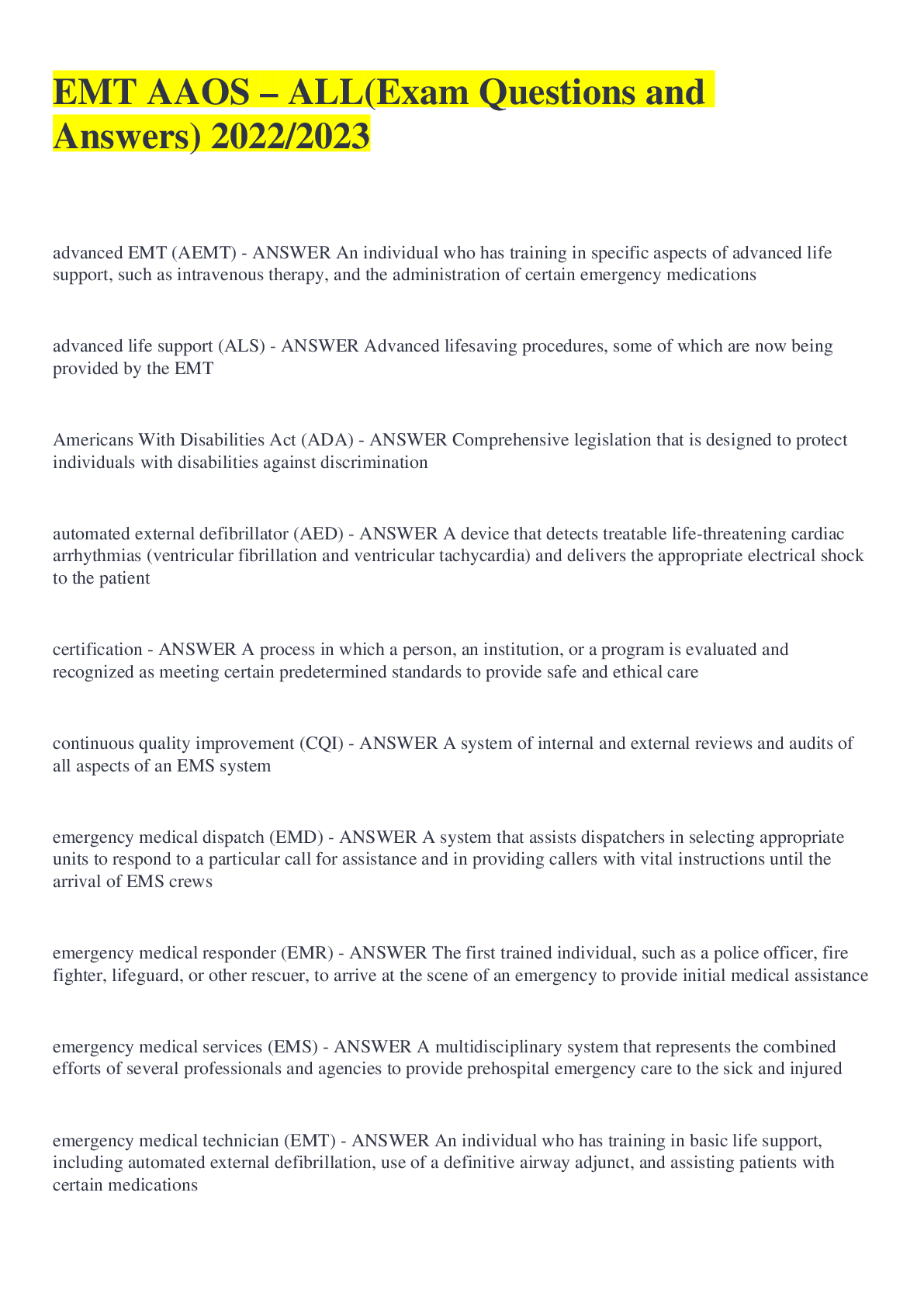
Buy this document to get the full access instantly
Instant Download Access after purchase
Buy NowInstant download
We Accept:

Reviews( 0 )
$10.00
Can't find what you want? Try our AI powered Search
Document information
Connected school, study & course
About the document
Uploaded On
Sep 05, 2022
Number of pages
86
Written in
Additional information
This document has been written for:
Uploaded
Sep 05, 2022
Downloads
0
Views
64

